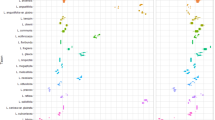Abstract
Genome size was measured in 75 samples of the wild pea species Pisum abyssinicum, P. elatius, P. fulvum and P. humile by ethidium-bromide (EB) flow cytometry (internal standard: Triticum monococcum) and Feulgen densitometry (internal standard: Pisum sativum ‘Kleine Rheinländerin’). Total variation of EB-DNA between samples covered 97.7% to 114.9% of the P. sativum value, and Feulgen DNA values were strongly correlated with EB-DNA values (r=0.9317, P < 0.001). Only P. fulvum was homogeneous in genome size (108.9% of P. sativum). Wide variation was observed between samples in P. abyssinicum (100.9–109.7%), P. elatius (97.7–114.9%) and P. humile (98.3–111.1% of P. sativum). In view of the world-wide genome size constancy in P. sativum, the present data are interpreted to show that the pea taxa with variable genome size are genetically inhomogeneous and that the current classification is not sufficient to describe the biological species groups adequately.
Similar content being viewed by others
References
Baranyi M, Greilhuber J (1995) Flow cytometric analysis of genome size variation in cultivated and wild Pisum sativum (Fabaceae). Plant Syst Evol 194:231–239
Baranyi M, Greilhuber J (1996) Flow cytometric and Feulgen densitometric analysis of genome size variation in Pisum. Theor Appl Genet 92:297–307
Ben-Ze'ev N, Zohary D (1973) Species relationship in the genus Pisum L. Israel J Bot 22:73–91
Conicella C, Errico A (1985) Identification of the chromosomes involved in translocations of P. abyssinicum and P. fulvum. In:Eucarpia Meeting on Pea Breeding. Plant Breeding Center C.N.R., Portici, Italy, pp 86–101
Conicella C, Errico A (1990) Karyotype variations in Pisum sativum ect. abyssinicum. Caryologia 43:87–97
Davis PH (1970) Pisum L. In:Davis PH (ed) Flora of Turkey, vol. 3. University Press, Edinburgh, pp 370–372
Errico A, Conicella C, Venora G (1991) Karyotype studies on Pisum fulvum and Pisum sativum, using a chromosome image analysis system. Genome 34:105–108
Govorov LI (1937) Gorokh (peas). In:Kul'turnaja flora SSSR. Selkhozgiz. Moskow and Leningrad
Greilhuber J, Ebert J (1994) Genome size variation in Pisum sativum. Genome 37:646–655
Greilhuber J, Ehrendorfer F (1988) Karyological approaches to plant taxonomy. In: Grimwade AM (ed) ISI atlas of science: plants and animals, vol. 1. Institute for Scientific Information, Philadelphia, pp 289–297
Hâkansson A (1936) Die Reduktionsteilung in einigen Artbastarden von Pisum. Hereditas 21:215–222
Lamprecht H (1964) Partielle Sterilität und Chromosomenstruktur bei Pisum. Agri Hort Genet 22:56–148
Lamprecht H (1974) Monographie der Gattung Pisum. Steiermärkische Landesdruckerei, Graz
Lehmann ChO (1954) Das morphologische System der Saaterbsen (Pisum sativum L. sens. lat. GOV. ssp. sativum). Züchter 24:316–337
Lehmann ChO, Blixt S (1984) Artificial infraspecific classification in relation to phenotypic manifestation of certain genes in Pisum. Agri Hort Genet 42:49–74
Makasheva RKh (1984) The pea. Balkema, Rotterdam
Rohlf FJ (1992) BIOM. A package of statistical programs to accompany the text “Biometry”. Applied Biostatistics, Inc., New York
Rosen G von (1944) Artkreuzungen in der Gattung Pisum, insbesondere zwischen P. sativum L. und P. abyssinicum Braun. Hereditas 30:261–400
Saccardo F (1971) Crosses among Pisum species. Pisum Newslett 3:38
Schweizer D, Davies D (1972) Nuclear DNA contents of Pisum genotypes grown in vivo and in vitro. Planta 106:23–29
Smartt J (1984) Evolution of grain legumes. I. Mediterranean pulses. Exp Agric 20:275–296
Zohary D, Hopf M (1973) Domestication of pulses in the Old World. Science 182:887–894
Author information
Authors and Affiliations
Additional information
Communicated by F. Mechelke
Rights and permissions
About this article
Cite this article
Baranyi, M., Greilhuber, J. & Swięcicki, W.K. Genome size in wild Pisum species. Theoret. Appl. Genetics 93, 717–721 (1996). https://doi.org/10.1007/BF00224067
Received:
Accepted:
Issue Date:
DOI: https://doi.org/10.1007/BF00224067




